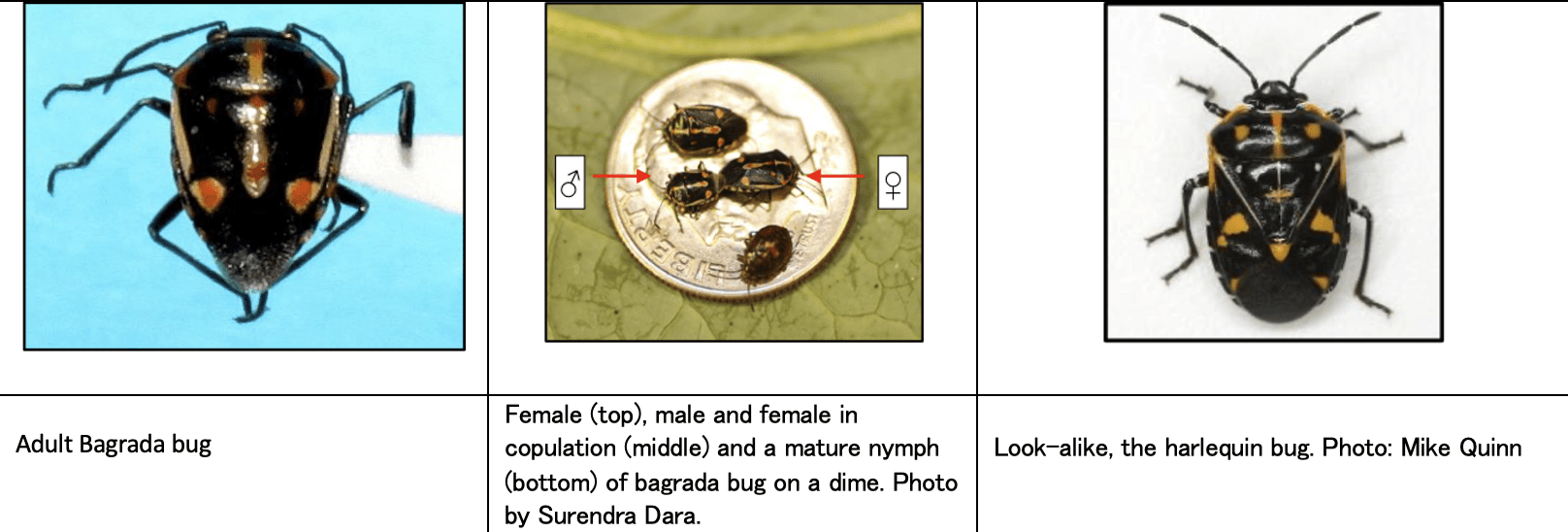Bagrada hilaris (burmeister)
Hemiptera: Pentatomidae

The Bagrada bug, also called painted bug, is a serious invasive pest relatively new to the Hawaiian Islands. First discovered on Maui (2014), it was subsequently found on Hawaii Island (2015) and Oahu (2016).
Identification
Approximately 5-7mm, adults have black, shield-shaped bodies with orange and white markings. Adults are often found mating in end-to-end position. Commonly mistaken for the harlequin bug, another stink bug about three times as large and with more orange markings and no white (photos below). Nymphs may resemble ladybird/ladybug beetles but have longer antennae and sucking mouth parts.
Creamy-white oval eggs are found in small clusters on the undersides of leaves, on hairy stems of non-host plants and in soil cracks. Eggs turn orange-red as embryos mature inside. The wingless bagrada bug nymphs develop through five instars. Newly molted nymphs of all ages are orange-red, but the legs, head, and thorax darken to black as nymphs get older. Male bugs are slightly smaller than females.

Hosts
Preferred hosts are cruciferous vegetable crops (Brassicacaea) including mustards, broccoli, cauliflower, cabbages, kale, radish, turnip, tatsoi, brussels sprouts, sweet alyssum, collards, and arugula. They also feed on flowering plants (sweet alyssum, sunflower); grasses (including corn, Sudan grass, Bermuda grass; various weeds, including shepherd’s purse, London rocket) and various other plants such as papaya, potato, maize, sorghum, cotton, capers, and some legumes.
Damage to plants
Bagrada bug nymphs and adults feed on leaves, stems, flowers and seeds. They insert their needle-like mouth parts into young leaves, inject digestive enzymes and suck the juices. Damage results in starburst-shaped lesions, “scorched” leaves, brown or white dead blotches, stunting, blind terminals, failure of head formation, severe damage to small plants/ seedings, or forked or multiple heads (on cauliflower, broccoli and cabbage).
Because adults and nymphs move from weeds into direct-seeded and transplanted cole crops, damage from the bagrada bug may be initially visible in the perimeter of the field. However, the infestation can rapidly progress throughout the field, as the adults are highly mobile. Fields that are near grassy areas, weedy areas (especially with cruciferous weeds), lush desert habitat, and residential areas with preferred hosts have a higher risk of being damaged by bagrada bug.

Management
- Early detection is important given that populcations can increase quickly.
- Look carefully for light green starburst lesions for possible infection (these may be easier to spot than insects at the early stage of infestation).
- Bagrata bugs tend to be more active during the hotter times of the day, so this is a good time to monitor.
- Remove insects when possible. Beat or shake plants over a tray or sheet of paper to monitor infestation. A hand held vacuum may also be used.
- Remove weed hosts near planting areas.
- Remove attractive host plants such as sweet alyssum.
- Traps:
- Pyramid traps baited with crushed sweet alyssum, inside polypropylene bags, can be used to catch and destroy bugs, particularly when numbers are high. These traps are available commercially as stink bug traps but the chemical lures sold to attract other stink bug species will not work against the bagrada bug.
- Cross-vane traps have been effective: https://sacmg.ucanr.edu/Insect_problems/Bagrada_Bug/
- Greenhouses, screened tunnels or floating row cover fabric can provide plant protection. The screening material mesh must be fine enough to exclude the bagrada bug nymphs and should be elevated so that it does not touch the plants because the bugs can feed through these coverings. Bury the edges of protective covers to prevent the bugs from crawling underneath to the plants.
- Insecticidal soap and horticultural oils provide some control against nymphs.
- Generally, stink bugs are difficult to manage with insecticides, and repeat applications are often necessary. Research suggests that synthetic pyrethroids, neonicotinoids, and organophosphate compounds may be effective in minimizing damage on cole crops.
- More at: https://cisr.ucr.edu/sites/default/files/2019-07/uc_ipm_bagrada_bug_nurseries.pdf)
- See also this CTAHR presentation on Brassica Pests: https://gms.ctahr.hawaii.edu/gs/handler/getmedia.ashx?moid=30917&dt=2&g=12.
This presentation noted that Entrust performed best out of organic treatments.
Distribution
The Bagrada bug is native to Africa, Asia, and the Middle East and it is found throughout much of Africa, India, and southern Europe. In the USA, the bagrada bug has established throughout most of California and in parts of Arizona, Hawaii, Nevada, New Mexico, Texas, and Utah. It also is established in 6 states of northern Mexico, and in Chile and Argentina in South America.
Sources
- Bagrada Bug, State of Hawaii Department of Agriculture: https://hdoa.hawaii.gov/pi/files/2013/01/Bagrada-hilaris-NPA4-5-16.pdf
- Bagrada Bug Discovery, UCCE Master Gardeners of Sacramento County: https://sacmg.ucanr.edu/Insect_problems/Bagrada_Bug/
- Bagrada Bug, Bagrada hilaris, UC Riverside Center for Invasive Species Research: https://cisr.ucr.edu/invasive-species/bagrada-bug
- Bagrada Bug, Pests in Gardens and Landscapes: https://ipm.ucanr.edu/PMG/PESTNOTES/pn74166.html
- Management of the Bagrada Bug in Nurseries: https://cisr.ucr.edu/sites/default/files/2019-07/uc_ipm_bagrada_bug_nurseries.pdf
- https://sacmg.ucanr.edu/Insect_problems/Bagrada_Bug/
- https://entnemdept.ufl.edu/creatures/veg/bagrada_bug.htm
JRS / MB – 5.18.23



